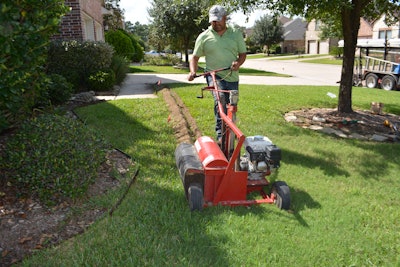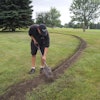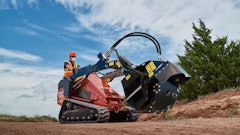
Every day we benefit from the precision achieved when professionals use tools designed specifically for their jobs. For instance, surgery would be far more risky and leave less than ideal results if surgeons didn't have sharp scalpels that allow them to work with extreme precision. Installing landscape irrigation lines is a similar endeavor, albeit less life threatening. When it’s done with the right tools, it can deliver precise and high-quality results, saving customers and contractors from headaches and labor costs.
Bill Waltz, owner of Green Oasis Irrigation in Tomball, Texas, knows that using the right tools for the job can have a huge impact on success. Waltz and his crew install and service sprinkler systems in southeastern Texas. The task involves digging trenches as narrow as 1 inch, as deep as 8 inches and, in some cases, hundreds of feet long for placing irrigation lines. When Waltz first started the business, it wasn’t always as easy as it sounds.
An Unexpected Business Partner
“One of my good friends and I were looking to keep ourselves busy one summer while we were home from college. When I saw a few guys installing a sprinkler system at the house across the street, I knew that was the ticket to passing time while earning some money,” Waltz said.
After some research and trips to the hardware store for supplies, Waltz and his partner were in business and ready for their first project of installing irrigation lines at Waltz’s childhood home. Following their first successful install, he and his partner began posting fliers to drum up business. Their efforts proved effective, but as the number of projects grew, their faith in their methods diminished.
“We started out using trenching shovels, which certainly got the job done, but our bodies paid the price,” he said. “They also didn’t leave the type of results we wanted to give our customers.”
Trenching by hand is a time-intensive and laborious process. In addition, the method greatly disturbs the soil, so customers had to wait as long as two months before their yards were back to normal.
“The longer soil and grass is left out of the trench, the more it dries out and the longer it takes for that area to heal once material is put back,” Waltz said. “If that’s our only option, that’s one thing, but we knew there had to be a better way.”
While visiting the local rental shop, Waltz and his partner found a Little Beaver Kwik-Trench mini-trencher—a 2.5- by 5-foot gas-powered machine that slices through soil, leaving trenches as narrow as 1 inch and as deep as 12 inches.
“Up until then, our only power trenching options were large models that would have destroyed lawns. They were overkill for what we needed,” Waltz said.
He added that many customers hear the word trencher and envision the lawns they work so hard to maintain turning into a dirt-filled warzone.
“That image isn’t too far from reality if you use larger trenchers. We knew we had to have clean, narrow trenches that could minimize cleanup time and deliver better results for our customers. The mini-trencher was our best option.”
Over the next few years Green Oasis rented the mini-trencher for nearly every irrigation project. The unit cut trenches as quickly as 30 feet per minute and its carbide-tipped blades rotated as fast as 800 RPM, delivering clean and precise results.
“Compliments started rolling in on the finished yard—a benefit we only could contribute to the Kwik-Trench,” Waltz said.
A job that started as a way to attain quick cash on college breaks developed into a thriving business opportunity. As soon as they had the funds, the team purchased the Kwik-Trench.
The Sharpest Tool in the Shed
That was nearly 28 years ago and, since then, Waltz’s partner has gone his own way. But Green Oasis has grown to 10 installers and two mini-trenchers working year-round to service customers.
“The mini-trenchers have really made our business stand out amongst the competition,” Waltz said. “I’ve had customers arrive home and think we hadn’t completed the job because the yard looked undisturbed. Clients have also been pleased with how fast their yards are back to normal.”
The Kwik-Trench deposits soil on one side of the trench, which makes backfilling easy and fast, and allows the area to heal quickly. The subsequent customer satisfaction helps fill much of Green Oasis’ business, which primarily comes from referrals.
Clients aren’t the only ones pleased with Waltz’s approach to digging trenches. His employees are also happy.
“I’ve had some of my guys say, if they had to dig by hand, they wouldn’t be working for me,” Waltz said. “Ergonomics is starting to play a big role in employee satisfaction and rightfully so. We’re not young forever.”
Operators walk behind the unit while pushing forward, which is easier and safer than larger trenchers that operate by pulling the unit backward. Green Oasis’ mini-trenchers are also relatively lightweight and easy to maneuver.
In addition to safety and ergonomics, the units also boosted profits for Green Oasis.
“It’s simple: Because we can cut trenches faster, we can complete projects more quickly, which means we can take on more than what can be achieved with hand-digging,” Waltz said.
One of the largest projects his crew completed with the mini-trenchers included installing irrigation lines on a 3-acre property outside of Tomball.
“It took us four days to complete the job—one of the longest projects we’ve worked on. But if we had hand dug the trenches, it would have taken us almost two weeks,” he said.
Efficiency continues to pay even on day-to-day projects, turning what could be two-day projects into six- to eight-hour jobs.
Having quick and timely parts support also helps the company stay on top of profits.
“We bill per project rather than hourly so, if we had to wait for parts to arrive, it could really eat into our profits,” Waltz said.
“I’m not sure why some contractors still choose to hand-dig their trenches, but for us, it’s a no-brainer,” Waltz said.
Having the right tools for the job is smart. Just like surgeons with their instruments, contractors with their mini-trenchers are poised to operate with precision to deliver fast, high-quality results. Whether it’s rescuing clients from an unsightly yard, or saving a contractor time, hassle and labor costs, the right tools pay.


![Screenshot 2025 04 02 153224 67ed9ef458841[1]](https://img.greenindustrypros.com/mindful/acbm/workspaces/default/uploads/2025/05/screenshot-2025-04-02-15322467ed9ef4588411.OmzYlWSXSm.png?auto=format%2Ccompress&fit=crop&h=100&q=70&w=100)







![Screenshot 2025 04 02 153224 67ed9ef458841[1]](https://img.greenindustrypros.com/mindful/acbm/workspaces/default/uploads/2025/05/screenshot-2025-04-02-15322467ed9ef4588411.OmzYlWSXSm.png?ar=16%3A9&auto=format%2Ccompress&fit=crop&h=135&q=70&w=240)







